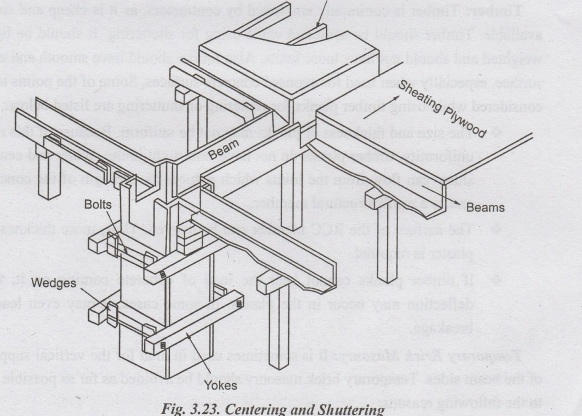Construction Materials And Technology: UNIT III: Construction Practices & Service Requirements
Centering and Shuttering
Requirements, Materials Used | Construction
Centering is used to support horizontal members. Hence, formwork for floor beams and slabs is known as centering. Shuttering is used to support vertical members.
CENTERING AND SHUTTERING
Centering
is
used to support horizontal members. Hence, formwork for floor beams and slabs
is known as centering. Shuttering is
used to support vertical members. Hence, formwork for columns, footings, or
retaining walls is known as shuttering. In general these are temporary
formworks in which the concrete is placed and allowed to hardened
REQUIREMENTS OF CENTERING AND SHUTTERING
The general requirements of shuttering and
centering are as follows:
❖ The surface of the form should be smooth
❖ It should be able to withstand all the loads
coming on it
❖ It should be able to retain its shape (horizontal
and vertical bracing is done for this)
❖ It should have minimum deflection under load
❖ It should be re-usable and should not be
costly
❖ It should be water-proof so that it does not
absorb water from the fresh concrete
❖ It should facilitate easy stripping during
the time of removal

MATERIALS USED FOR CENTERING AND SHUTTERING
Steel and timber are commonly used as
shuttering and centering material, former for its efficiency and later for its
cost-effectiveness.
Steel:
Panels are fabricated from thin steel plates and small steel angles are used
along the edges to stiffen these plates. Clamps, nuts, or bolts are used to
hold the steel panels together. Steel is considered the best material for
centering and shuttering. The reasons are explained below:
❖ Steel provides a watertight formwork so that
strength of the cement pnis concrete is preserved
❖ It can bear the load coming on it easily
❖ It can be used for vertical, horizontal, or
any type of formwork
❖ It provides a levelled surface of concrete.
Desired appearance based on architectural recommendations is easy to achieve
with the help of steel formwork
❖ As the
bottom surface of the structural member is levelled, less thickness of plaster
is required
Timber:
Timber
is commonly employed by contractors, as it is cheap and easily available.
Timber should be seasoned while using for shuttering. It should be light-
weighted and should not have loose knots. Also timber should have smooth and
even surface, especially when used for exposed concrete surfaces. Some of the
points to be considered while using timber planks for centering or shuttering
are listed below:
❖ The size and thickness of planks may not be
uniform. Because of this non- uniformity, timber planks do not have watertight
joints. Water and cement slurry can flow from the joints which reduces the
strength of the concrete and as a result structural member.
❖ The surface of the RCC member can be uneven.
Thus, more thickness of plaster is required.
❖ If timber
planks cannot bear the load of concrete coming on it, then deflection may occur
in the planks. In some cases, it may even lead to breakage.
Temporary
Brick Masonry: It is sometimes used in mud for the vertical
supports of the beam sides. Temporary brick masonry should be avoided as far as
possible due to the following reasons:
❖ The brick masonry soaks the cement slurry
from the member. Thus, the strength of the member is greatly affected.
❖ Moreover,
the brick masonry formwork cannot bear the weight of vibrator, so proper
compaction of the structural member is not possible. This again reduces the
strength. here
❖ An uneven surface of RCC member is obtained
requiring more thickness of plaster.
Construction Materials And Technology: UNIT III: Construction Practices & Service Requirements : Tag: : Requirements, Materials Used | Construction - Centering and Shuttering
Related Topics
Related Subjects
Construction Materials and Technology
CE3302 3rd Semester Civil Dept 2021 Regulation | 3rd Semester Civil Dept 2021 Regulation
